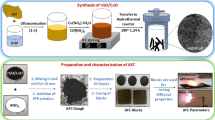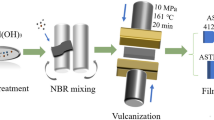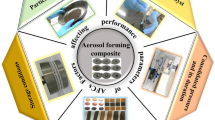Abstract
The elimination of halon and frequent fire accidents have caused an urgent need for the development of high-efficient fire extinguishing agents. ABC dry powder has been paid much attention, and has become one of the most extensively used fire extinguishing agents nowadays owing to its wide applications in various fire protection fields. Therefore, to enhance the fire-extinguishing properties of ABC dry powder, ferrocene was used as the additive to develop a new composite ultrafine dry powder based on an ultrafine ABC dry powder product. Through flame inhibition tests, two performance indexes of the inhibition process, namely temperature drops and flame height variations, were adopted to measure the degree of flame suppression. The experimental results revealed that the temperature drops and flame height variations both increased and then decreased. Moreover, the composite ultrafine dry powder containing 0.7% ferrocene displayed the best inhibitory effect with the maximum temperature drop (152.9°C) and variation rate of flame height (14.01%). Thermogravimetric analysis and differential scanning calorimetry were used to analyze the thermal decomposition of the sample powders. Furthermore, based on the analysis results of the thermal decomposition temperature, weight loss, and other thermodynamic parameters of the sample powders, the reasons for performance advantages of composite ultrafine dry powder containing 0.7% ferrocene were clarified as the faster pyrolysis rate, more absorption of heat, stronger suffocation and chemical inhibition effect. Finally, possible speculations on the suppression mechanisms of composite ultrafine dry powder containing 0.7% ferrocene were proposed.









Similar content being viewed by others
References
Wofsy SC, McElroyp MB, Sze ND (1975) Freon consumption: implications for atmospheric ozone. Science 187:535–536. https://doi.org/10.1126/science.187.4176.535
Salawitch RJ, Wofsy SC, McElroy MB (1988) Chemistry of OClO in the Antarctic stratosphere: implications for bromine. Planet Space Sci 36:213–224. https://doi.org/10.1016/0032-0633(88)90058-X
Hamins A, Trees D, Seshadri K (1994) Extinction of nonpremixed flames with halogenated fire suppressants. Combust Flame 99:221–30. https://doi.org/10.1016/0140-6701(95)93665-3
Xu W, Jiang Y, Ren X (2016) Combustion promotion and extinction of premixed counterflow methane/air flames by C6F12O fire suppressant. J Fire Sci 34:4. https://doi.org/10.1177/0734904116645829
Gurchumelia L, Bezarashvili G, Chikhradze M et al (2009) Investigation of performance properties of novel composite fire-extinguishing powders based on mineral raw materials. IEEE Trans Eng Manag 64:337–343. https://doi.org/10.2495/MC090321
Sheu GL, Zhang LQ (2009) Powder extinguishing agent and method for manufacturing the same. Patent 20090146098 A1, US
Liu H, Zong R, Gao J et al (2014) A good dry powder to suppress high building fires. APCBEE Proc 9:291–295. https://doi.org/10.1016/j.apcbee.2014.01.052
Kuang K, Chow WK, Ni X et al (2011) Fire suppressing performance of superfine potassium bicarbonate powder. Fire Mater 35(6):353–366. https://doi.org/10.1002/fam.1058
Like J, Moore TA, Mather JD (2000) Handheld fire extinguisher development. In: Paper presented at the Halon options technical working conference (HOTWC), Gaithersburg, MD, NISTSP984, National Institute of Standards and Technology
Brooks J, Berezovsky J, Dwyer MO (2002) Aerosol fire suppression for high rise structural applications via aircraft distribution using metalstorm technologies. In: Paper presented at the Halon options technical working conference (HOTWC), Albuquerque, NM, NISTSP984, National Institute of Standards and Technology
Ewing CT, Faith FR, Hughes JT et al (1989) Flame extinguishment properties of dry chemicals: extinction concentrations for small diffusion pan fires. Fire Technol 25:134–149. https://doi.org/10.1007/BF01041422
Kennington R, Woolhouse RA (1978) Preparation of the reaction product of urea and alkali metal hydroxide or carbonate. Patent US4107053, US
Kuang K, Huang X, Liao G (2008) A comparison between superfine magnesium hydroxide powders and commercial dry powders on fire suppression effectiveness. Process Saf Environ 86:182–188. https://doi.org/10.1016/j.psep.2007.11.002
Huang D, Wang X, Yang J (2015) Influence of particle size and heating rate on decomposition of BC dry chemical fire extinguishing powders. Part Sci Technol. https://doi.org/10.1080/02726351.2015.1013591
Ni X, Kuang K, Yang D et al (2009) A new type of fire suppressant powder of NaHCO3/zeolite nanocomposites with core–shell structure. Fire Saf J 44:968–975. https://doi.org/10.1016/j.firesaf.2009.06.004
Fleming JW, Reed MD, Zegers EJP et al (1998) Extinction studies of propane/air counterflow diffusion flames: the effectiveness of aerosols. In: Paper presented at the Halon options technical working conference (HOTWC), NIST SP 984, National Institute of Standards and Technology, Gaithersburg, MD, USA
Song F, Du Z, Cong X et al (2014) Experimental study on fires extinguishing properties of melamine phosphate powders. Proc Eng 84:535–542. https://doi.org/10.1016/j.proeng.2014.10.465
McHale BG (2002) Mixed phase fire suppression systems: application and benefits. In: Paper presented at the Halon options technical working conference (HOTWC), NIST SP
Skaggs RR (2002) Assessment of the fire suppression mechanics for HFC-227ea combined with NaHCO3. In: Paper presented in proceedings of the Halon options technical working conference
Morton DAV (1999) Fire suppressant powder. Patent US5938969, US
Linteris GT, Knyazev VD, Babushok VI (2002) Inhibition of premixed methane flames by manganese and tin compounds. Combust Flame 129:221–238. https://doi.org/10.1016/S0010-2180(02)00346-2
Hessler G, Ucan N (2012) Fire extinguishing agent, in particular dry powder mixtures, method for the production thereof and use. Patent EP2496315, EP
Warnock WR, Flatt DV, Eastman JR (1971) Anti-reflash dry chemical agent. Patent US3553127, US
Linteris GT, Rumminger MD, Babushok V et al (2000) Flame inhibition by ferrocene and blends of inert and catalytic agents. In: Paper presented in proceedings of the combustion institute 28(2):2965–2972. https://doi.org/10.1016/S0082-0784(00)80722-5
Marc D, Rumminger MD, Reinelt D et al (1998) Inhibition of flames by iron pentacarbonyl. In: Paper presented at the Halon options technical working conference
Reinelt D, Linteris GT (1996) Experimental study of the flame inhibition effect of iron pentacarbonyl. In: Paper presented at the Halon options technical working conference
Rausch M, Vogel M, Rosenberg H (1957) Ferrocene: a novel organometallic compound. J Chem Educ 34(6):268. https://doi.org/10.1021/ed034p268
Koshiba Y, Iida K, Ohtani H (2015) Fire extinguishing properties of novel ferrocene/surfynol 465 dispersions. Fire Saf J 72:1–6. https://doi.org/10.1016/j.firesaf.2015.02.011
Staude BS, Bergmann U, Atakan B (2011) Experimental and numerical investigations of ferrocene-doped propene flames. Z Phys Chem 225:1179–1192. https://doi.org/10.1524/zpch.2011.0157
Linteris GT, Katta VR, Takahashi F (2004) Experimental and numerical evaluation of metallic compounds for suppressing cup-burner flames. Combust Flame 138:78–96. https://doi.org/10.1016/j.combustflame.2004.04.003
Carty P, Grant J, Metcalfe E (2010) Flame-retardancy and smoke-suppression studies on ferrocene derivatives in PVC. Appl Organomet Chem 10(2):101–111. https://doi.org/10.1002/(SICI)1099-0739(199603)10:2%3c101:AID-AOC484%3e3.0.CO;2-7
Rumminger MD, Linteris GT (2002) The role of particles in the inhibition of counterflow diffusion flames by iron pentacarbonyl. Combust Flame 128(1–2):145–164. https://doi.org/10.1016/s0010-2180(01)00341-8
Howard JB, Kausch WJ, Soot T et al (1980) Soot control by fuel additives. Prog Energy Combust Sci 6(3):263–276. https://doi.org/10.1016/0360-1285(80)90018-0
Kasper M, Siegmann K (1998) The influence of ferrocene on PAH synthesis in acetylene and methane diffusion flames. Combust Sci Technol 140(1–6):333–350. https://doi.org/10.1080/00102209808915777
Kasper M, Sattler K, Siegmann K et al (1999) The influence of fuel additives on the formation of carbon during combustion. J Aerosol Sci 30(2):217–225. https://doi.org/10.1016/S0021-8502(98)00034-2
Linteris GT, Rumminger MD, Babushok VI (2008) Catalytic inhibition of laminar flames by transition metal compounds. Prog Energy Combust Sci 34(3):288–329. https://doi.org/10.1016/j.pecs.2007.08.002
Ni X, Kuang K, Wang X et al (2009) A new type of BTP/zeolites nanocomposites as mixed-phase fire suppressant: preparation, characterization, and extinguishing mechanism discussion. J Fire Sci 28:5–25. https://doi.org/10.1177/0734904109340763
Font R, Fullana A, Conesa JA et al (2001) Analysis of the pyrolysis and combustion of different sewage sludges by TG. J Anal Appl Pyrol 58(2):927–941. https://doi.org/10.1016/S0165-2370(00)00146-7
Muthuraman M, Namioka T, Yoshikawa K (2010) Characteristics of co-combustion and kinetic study on hydrothermally treated municipal solid waste with different rank coals: a thermogravimetric analysis. Appl Energy 87(1):141–148. https://doi.org/10.1016/j.apenergy.2009.08.004
Damartzis T, Vamvuka D, Sfakiotakis S et al (2011) Thermal degradation studies and kinetic modeling of cardoon (Cynara cardunculus) pyrolysis using thermogravimetric analysis (TGA). Bioresour Technol 102(10):6230–6238. https://doi.org/10.1016/j.biortech.2011.02.060
Koshiba Y, Takahashi Y, Ohtani H (2012) Flame suppression ability of metallocenes (nickelocene, cobaltcene, ferrocene, manganocene, and chromocene). Fire Saf J 51:10–17. https://doi.org/10.1016/j.firesaf.2012.02.008
Bhattacharjee A, Rooj A, Roy D et al (2014) Thermal decomposition study of ferrocene [(C5H5)2Fe]. J Exp Phys 2014(5):601–612. https://doi.org/10.1155/2014/513268
Su CH, Chen CC, Liaw HJ et al (2014) The assessment of fire suppression capability for the ammonium dihydrogen phosphate dry powder of commercial fire extinguishers. Proc Eng 84:485–490. https://doi.org/10.1016/j.proeng.2014.10.459
Kibert CJ, Dierdorf D (1994) Solid particulate aerosol fire suppressants. Fire Technol 30(4):387–399. https://doi.org/10.1007/BF01039940
Ewing CT, Faith FR, Romans JB et al (1995) Extinguishing class B fires with dry chemicals: scaling studies. Fire Technol 31(1):17–43. https://doi.org/10.1007/BF01305266
Ewing CT, Hughes JT, Carhart HW (1984) The extinction of hydrocarbon flames based on the heat-absorption processes which occur in them. Fire Mater 8(3):148–156. https://doi.org/10.1002/fam.810080305
Ewing CT, Faith FR, Hughes JT et al (1989) Evidence for flame extinguishment by thermal mechanisms. Fire Technol 25(3):195–212. https://doi.org/10.1007/bf01039778
Romans JB, Hughes JT, Charhart HW (1992) Flame extinguishment properties of dry chemicals: extinction weights for small diffusion pan fires and additional evidence for flame extinguishment by thermal mechanisms. J Fire Prot Eng 4(2):35–51. https://doi.org/10.1177/104239159200400201
Ewing CT, Beyler C, Carhar HW (1994) Extinguishment of class B flames by thermal and chemical actions; principles underlying a complete theory; prediction of flame extinguishing effectiveness. J Fire Prot Eng 6(1):23–54. https://doi.org/10.1177/104239159400600103
Abdel-Kader A, Ammar AA, Saleh SI (1991) Thermal behaviour of ammonium dihydrogen phosphate crystals in the temperature range 25–600°C. Thermochim Acta 176:293–304. https://doi.org/10.1016/0040-6031(91)80285-Q
Urano K, Kiyoura R (1970) Mechanism, kinetics, and equilibrium of thermal decomposition of ammonium sulfate. Ind Eng Chem Process Des Dev 9(4):489–494. https://doi.org/10.1021/i260036a001
Halstead WD (1970) Thermal decomposition of ammonium sulphate. J Chem Technol Biot 20(4):4. https://doi.org/10.1002/jctb.5010200408
Dyagileva LM, Mar’In VP, Tsyganova EI et al (1979) Reactivity of the first transition row metallocenes in thermal decomposition reaction. J Organomet Chem 175(1):63–72. https://doi.org/10.1016/S0022-328X(00)82299-8
Leonhardt A, Hampel S, Muller C et al (2006) Synthesis, properties, and applications of ferromagnetic-filled carbon nanotubes. Chem Vapor Depos 12(6):380–387. https://doi.org/10.1002/cvde.200506441
Rumminger MD, Reinelt D, Babushok V et al (1999) Numerical study of the inhibition of premixed and diffusion flames by iron pentacarbony. Combust Flame 123(1):82–94. https://doi.org/10.1016/S0010-2180(00)00153-X
Funding
Funding was provided by National Natural Science Foundation of China (Grant No. 51704171), Postdoctoral Science Foundation of China (General Program) (Grant No. 2016M601796), Six Talent Peaks Project of Jiangsu (Grant No. 2014-XCL-010), Priority Academic Program Development of Jiangsu Higher Education Institutions.
Author information
Authors and Affiliations
Corresponding author
Additional information
Publisher's Note
Springer Nature remains neutral with regard to jurisdictional claims in published maps and institutional affiliations.
Rights and permissions
About this article
Cite this article
Li, H., Du, D., Guo, X. et al. Experimental Study on the Optimum Concentration of Ferrocene in Composite Ultrafine Dry Powder. Fire Technol 56, 913–936 (2020). https://doi.org/10.1007/s10694-019-00912-x
Received:
Accepted:
Published:
Issue Date:
DOI: https://doi.org/10.1007/s10694-019-00912-x




